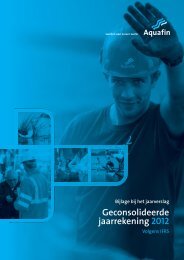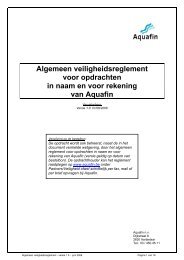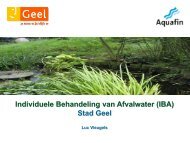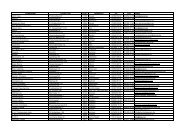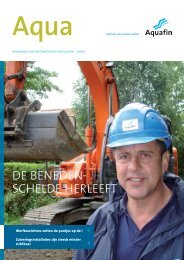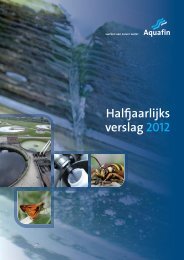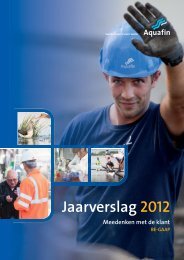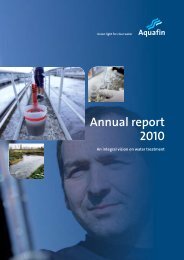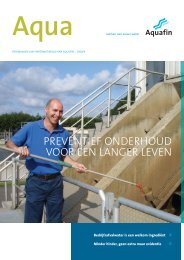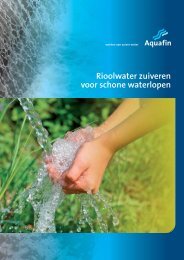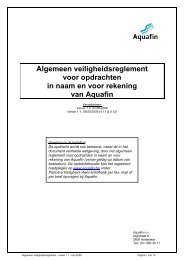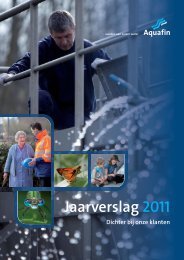Consolidated financial statement 2011 - Aquafin
Consolidated financial statement 2011 - Aquafin
Consolidated financial statement 2011 - Aquafin
You also want an ePaper? Increase the reach of your titles
YUMPU automatically turns print PDFs into web optimized ePapers that Google loves.
30<br />
<strong>Consolidated</strong> <strong>financial</strong> <strong>statement</strong> <strong>2011</strong><br />
The early retirement scheme is also processed as a defined<br />
benefit plan inasmuch as the group has an actual liability with<br />
respect to the employees concerned. The group acknowledges<br />
a provision on the balance that is calculated in accordance<br />
with the ‘projected unit credit method’.<br />
n<br />
Estimates and assumptions<br />
To execute its (supramunicipal) contracts, <strong>Aquafin</strong> NV<br />
entered into a management agreement with the Flemish<br />
Region. The management agreement sets out the tasks of<br />
<strong>Aquafin</strong> NV and the payments that the company will receive<br />
for those tasks.<br />
The elements from that management agreement, which<br />
have been set out below, are crucial to the further assessment<br />
of the accounts.<br />
• All of the reasonable costs that <strong>Aquafin</strong> NV makes in the<br />
context of the supramunicipal sanitation of household<br />
wastewater are paid by the Flemish Region through<br />
the drinking water companies.<br />
• The management agreement has a rolling nature, which<br />
means that it is automatically extended every year<br />
unless one of the parties has terminated the agreement.<br />
The notice period for termination is 20 years.<br />
• During the execution of the management agreement,<br />
<strong>Aquafin</strong> NV has the right of use and enjoyment of the<br />
infrastructure created, purchased or leased by the<br />
company. At the end of the management agreement<br />
– after the settlement of all remaining payments due –<br />
the ownership of that infrastructure will be transferred<br />
to the Flemish Region at no charge.<br />
• During the execution of the management agreement,<br />
the construction and operations risks are borne by<br />
<strong>Aquafin</strong> NV.<br />
The interpretation IFRIC 12 - Service Concession Agreements<br />
applies to public-private agreements if the following<br />
conditions are satisfied:<br />
• the party that grants the concession ('grantor') controls<br />
or regulates the services that the operator is required<br />
to provide with the infrastructure, whom those services<br />
are to be delivered to, and the price;<br />
• the grantor controls the ultimate right through<br />
ownership. In other words, the grantor has control over<br />
the significant residual value in the infrastructure at<br />
the end of the life of the agreement.<br />
The most important characteristic of the aforementioned<br />
interpretation is the nature of the services. The activities of<br />
the operator must be of ´public utility´ (the so-called 'public<br />
service obligation'). The services related to the infrastructure<br />
are provided by <strong>Aquafin</strong> to the public (in the broad sense of<br />
the term) within a pre-determined policy, i.e. the management<br />
agreement. This determines which 'public' services are to be<br />
provided, to wit, the expansion and management of the<br />
supramunicipal infrastructure for treating household<br />
wastewater.<br />
Infrastructure assets within the scope of the agreement<br />
are assets built or acquired for use within the context of<br />
the concession agreement or existing infrastructure to which<br />
the operator has been granted access.<br />
All of the infrastructure built, purchased or leased by<br />
<strong>Aquafin</strong> NV in the context of the management agreement<br />
with the Flemish Region falls within the scope of this<br />
interpretation. As a result, the infrastructure concerned is not<br />
treated as tangible fixed assets in the <strong>financial</strong> <strong>statement</strong><br />
of the company.<br />
PRINCIPLES FOR THE ITEMS OF THE BALANCE<br />
STATEMENT<br />
n<br />
n<br />
Intangible assets<br />
Research and development<br />
Expenditures on research activities are recognized in the<br />
results for the period in which they were incurred.<br />
Lease agreements<br />
a. The group as lessee<br />
The group has entered into several operational lease<br />
agreements. They therefore do not include a transfer of<br />
the actual risks and rewards of ownership. In the event<br />
of operational leases, the lease payments are shown as<br />
costs and are distributed linearly over the lease period.<br />
b. The group as lessor<br />
Lease agreements in which the group acts as lessor are<br />
classified as <strong>financial</strong> leases if the group transfers<br />
substantially all of the risks and rewards of ownership<br />
of an asset to the lessee. The group will include a claim<br />
in the balance <strong>statement</strong> that is equal to the net<br />
investment in the lease.



